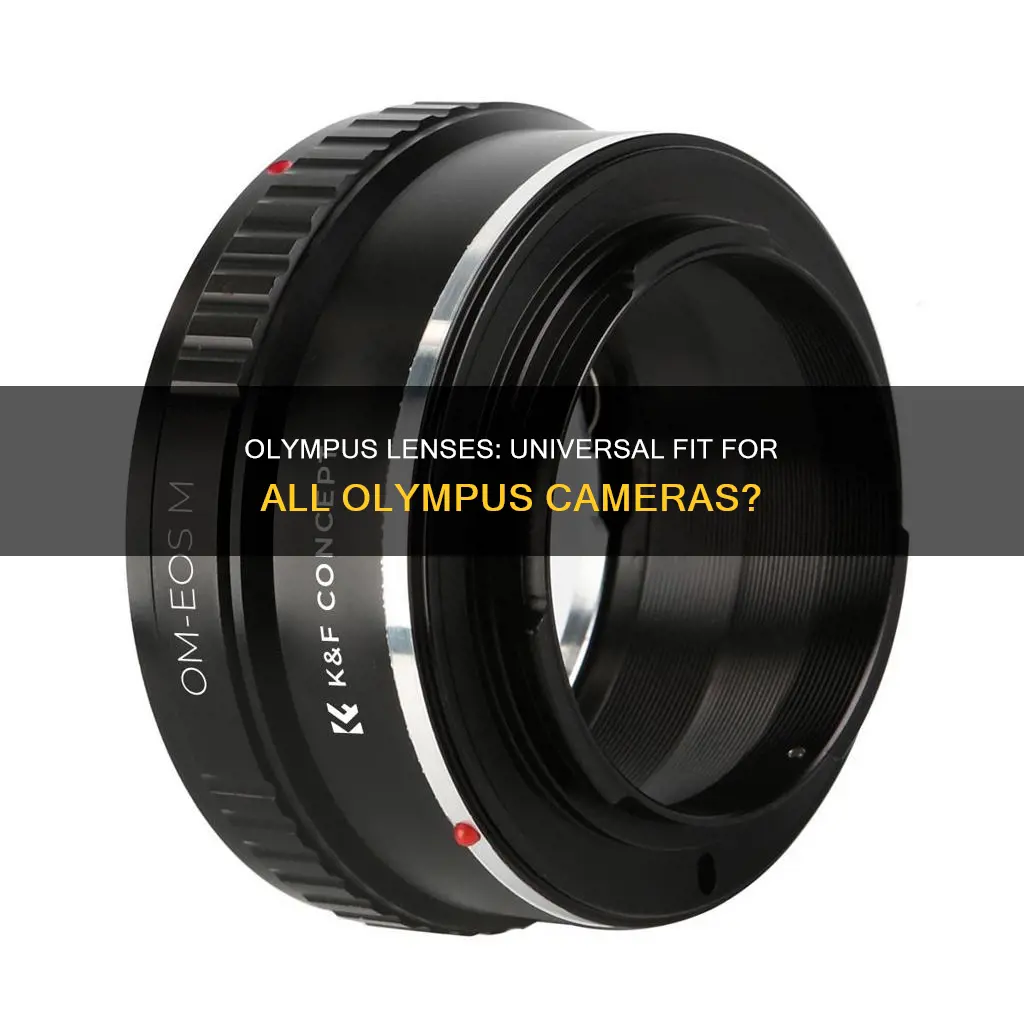
When it comes to the compatibility of Olympus lenses with Olympus cameras, the answer is not as straightforward as a simple yes or no. While some Olympus lenses may fit specific Olympus camera models, there are several factors and variations to consider. Firstly, it is important to distinguish between the different types of lenses and camera bodies within the Olympus ecosystem. For example, the Zuiko lenses, which are designed for DSLR cameras, may not be compatible with all Olympus camera models. In some cases, adapters may be required to attach a lens to a particular camera body. Additionally, the Micro Four Thirds (MFT) standard, which is used by both Olympus and Panasonic, ensures cross-brand compatibility to some extent. However, even within this standard, there are variations in lens and camera designs that can affect compatibility.
| Characteristics | Values |
|---|---|
| Lens compatibility | M.Zuiko lenses can be mounted on Lumix bodies, and Panasonic-Leica or Lumix optics can be attached to an OM-D or PEN camera. |
| Camera-lens mount standard | Micro Four Thirds |
| Image stabilisation | The in-body and in-lens stabilisation systems of Olympus and Panasonic do not cooperate with each other. |
| Aperture ring | Works only on Lumix cameras. |
| Lens function button | Cannot be programmed on Panasonic Lumix cameras. |
| Depth from defocus | Continuous AF of Panasonic cameras fitted with Olympus lenses is relatively slow and less confident. |
| Zoom ring rotation | The zoom rings on Olympus and Panasonic lenses turn in opposite directions. |
| Purple flare | Some Panasonic lenses when used on an Olympus body can produce marked purple flare and fringing. |
| Tele-converters | The Olympus MC-14 does not fit on the Panasonic 50-200mm and 200mm lenses, and the TC-14 and TC-20 cannot be mounted on the Olympus 40-150mm and 300mm lenses. |
| In-camera lens correction | Pre-2013 Olympus cameras in combination with a Panasonic lens might show strong colour fringing. |
What You'll Learn

Zuiko lenses may not fit other camera models
Zuiko lenses are designed for Olympus cameras, and while they may fit other camera models, there are some compatibility issues to consider. Zuiko lenses are known for their superior image quality, compact design, and fast autofocus performance. However, when used with non-Olympus cameras, certain features may not function as intended.
One issue is the image stabilization technology, which is specific to each manufacturer. Olympus's in-body and in-lens stabilization systems do not work in tandem with Panasonic's stabilization mechanisms. Additionally, the customizable "L-Fn" button on some Olympus lenses does not function as expected when mounted on Panasonic Lumix cameras, limiting the user's ability to change shooting settings on the fly.
Another consideration is the direction of the zoom ring rotation. Olympus lenses zoom from long to wide with a clockwise turn, while Panasonic lenses zoom from wide to long, following the convention of other camera brands like Fujifilm, Leica, and Nikon. This can be a source of confusion and frustration for photographers accustomed to one system when switching to the other.
Furthermore, certain Panasonic lenses, such as the Panasonic-Leica 1.7/15mm, feature an aperture ring that allows direct control over the lens aperture. However, this feature is only functional on Lumix cameras and does not work when mounted on Olympus cameras.
It is also worth noting that Olympus has addressed the limitations of contrast detect autofocus (CDAF) by incorporating on-sensor phase detect pixels in its flagship cameras, while Panasonic developed the Depth-from-Defocus (DFD) technology. As a result, continuous autofocus performance may vary when using Panasonic lenses on Olympus bodies or vice versa.
Lastly, some Panasonic lenses may exhibit purple flare and fringing when used on Olympus bodies due to differences in UV filtration between the two manufacturers. This issue can be mitigated by using UV filters on the affected lenses.
In summary, while Zuiko lenses may physically fit other camera models, certain features and functionalities may be compromised, impacting the overall shooting experience and image quality. It is advisable to refer to compatibility tables and user experiences before attempting to mix and match camera bodies and lenses from different manufacturers.
Compatibility of Pentax Lenses with Fujica Cameras
You may want to see also

Adapters may be required for lenses to fit
When it comes to fitting Olympus lenses to Olympus cameras, adapters may be required. This is particularly true if you're dealing with older lenses or a mix of Olympus and Panasonic gear. Let's explore this in more detail:
Olympus OM-Mount Lenses and Canon Cameras
First, let's address a specific scenario: using an Olympus OM-mount lens on a Canon DSLR. In this case, you would indeed need an adapter. The good news is that there are OM-to-EF adapters available on the market, such as the Fotasy adapter, which promises infinity focus. However, keep in mind that these adapters are essentially simple metal rings without electrical contacts. This means that features like automatic diaphragm auto-focusing or other electronic functions won't work, and you'll need to manually adjust exposure and focus.
Olympus and Panasonic Micro Four Thirds Compatibility
Now, let's shift our focus to the Micro Four Thirds (MFT) standard, which is adhered to by both Olympus and Panasonic. This means that, in theory, you can mount M.Zuiko lenses on Lumix bodies and Panasonic-Leica or Lumix optics on OM-D or PEN cameras. This cross-brand compatibility is one of the strengths of the MFT system, offering a wide range of alternatives for photographers.
However, the MFT standard only dictates the camera-lens mount, and other design aspects can vary between Olympus and Panasonic. As a result, several compatibility issues may arise when mixing gear from these two brands:
- Image Stabilization: The image stabilization technologies of Olympus and Panasonic are manufacturer-specific. For example, the optical image stabilization of some Panasonic OIS lenses won't function properly when mounted on certain Olympus bodies. Additionally, the in-body and in-lens stabilization systems of the two brands don't cooperate with each other, so you won't get the benefit of combined stabilization mechanisms when mixing lenses and bodies.
- Aperture Control: Most lenses from both brands have their aperture controlled through the camera. However, some Panasonic-Leica lenses feature an aperture ring, allowing direct control on the lens. Unfortunately, this feature only works on Lumix cameras and is inactive when mounted on Olympus cameras.
- Lens Function Button: Olympus PRO-line lenses often have a customizable "L-Fn" button for easy access to shooting settings. On Olympus bodies, this button can be programmed for various functions. However, on Panasonic Lumix cameras, it is locked to its default behavior as a focus stop button.
- Autofocus Performance: Olympus has implemented on-sensor phase-detect pixels in its flagship cameras to improve autofocus tracking. Panasonic, on the other hand, uses Depth-from-Defocus (DFD) technology. When you mix brands, continuous AF performance may suffer. For instance, using Olympus lenses on Panasonic bodies can result in slower and less confident autofocus.
- Zoom Ring Rotation: Olympus and Panasonic lenses have opposite zoom ring rotations. This can be confusing if you frequently switch between lenses of the two brands.
- Purple Flare and Fringing: Some Panasonic lenses, when used on Olympus bodies, can produce marked purple flare and fringing due to differences in UV filtration. This issue typically affects specific Panasonic lenses and is not observed when using Olympus lenses on Panasonic bodies.
- Tele-converter Compatibility: Both Olympus and Panasonic offer tele-converters for their telephoto lenses. However, due to design differences, these converters are not cross-brand compatible, limiting your options when mixing lenses and bodies.
- In-camera Lens Correction: Older Olympus cameras may not apply corrections for chromatic aberration when using Panasonic lenses, resulting in stronger color fringing. In such cases, shooting in RAW format is recommended for easier correction during post-processing.
In summary, while it is possible to mix and match Olympus and Panasonic MFT gear, adapters are often not required for a physical fit. However, there are a host of compatibility issues that can affect your photography experience and results. These range from autofocus performance and image stabilization to lens-specific features and in-camera corrections. Therefore, it is essential to be aware of these potential limitations before investing in a mixed Olympus-Panasonic setup.
CCD Camera Lenses: Color Corrected or Not?
You may want to see also

Some lenses may not autofocus on certain camera bodies
When it comes to the compatibility of Olympus lenses with their cameras, it's important to note that some lenses may experience autofocus issues with certain camera bodies. This can be a common problem for photographers, resulting in frustration and potentially impacting their work.
In the case of Olympus cameras and lenses, the autofocus function relies on the seamless transfer of information between the camera body and the lens. This communication occurs through electrical contacts on both the camera and the lens. If these contacts become dirty or corrupted in any way, it can lead to autofocus malfunctions. Therefore, it is crucial to keep these contacts clean and free of debris. However, when cleaning, one should exercise caution by using only a dry, clean cloth to wipe the contacts gently. Using a wet cloth or touching the contacts directly with your hands can lead to malfunctions and corrosion.
Another factor that can impact autofocus is the secure mounting of the lens onto the camera body. If the lens is not properly attached, it may hinder the exchange of information between the two, resulting in autofocus issues. Thus, it is essential to ensure that the lens is securely mounted according to the instructions provided by the manufacturer.
Additionally, it's worth noting that older lenses may not perform as well on newer camera bodies. This is because newer cameras often have more advanced autofocus systems that require faster and more precise communication between the camera and the lens. As a result, older lenses may struggle to keep up with the autofocus demands of modern camera bodies.
In some cases, the autofocus issues may be specific to certain lens models or camera body designs. For instance, the Zuiko Digital lenses, which are older, may not autofocus or may do so very slowly on particular Olympus camera bodies, such as the m4/3. This incompatibility can be a significant concern for photographers who have invested in these lenses and are considering upgrading their camera bodies.
To address autofocus issues, photographers can take several steps. Firstly, ensuring that the lens and camera contacts are clean is vital. Secondly, checking that the lens is securely mounted is crucial. Lastly, referring to the camera's instruction manual to adjust any custom function settings related to autofocus, such as the [C.Fn-10: Shutter/AE lock button], can be beneficial. If these steps do not resolve the issue, seeking assistance from a professional service centre is recommended.
Renting Camera Lenses: Best Places to Get Them
You may want to see also

Image stabilisation may not work with certain lens-camera combinations
Image stabilisation is a technology built into your lens or camera body to help minimise blur caused by camera shake. It is particularly useful when shooting handheld in low light and using slow shutter speeds. However, it is important to note that image stabilisation does not help to freeze fast-moving subjects – only a fast shutter speed can do that.
There are two types of image stabilisation: lens-based and in-camera. Lens-based stabilisation uses a floating lens element that is electronically controlled and shifted in the opposite direction to any camera shake recorded by the camera. In-camera systems, on the other hand, physically shift the image sensor to compensate for camera shake.
While image stabilisation can be a valuable tool in many situations, it may not work with certain lens-camera combinations. For example, if you are using a lens with image stabilisation on a camera body that also has built-in stabilisation, the two systems may not work together effectively. In some cases, you may need to choose between using one or the other, rather than both simultaneously. Additionally, older lenses and entry-level systems may not have certain stabilisation features or may not operate properly when panning, resulting in more blurring.
Furthermore, image stabilisation is most effective at shutter speeds between 1/1000 and 1 second. At very fast shutter speeds, image stabilisation is not necessary as there is little time for camera shake to occur. Conversely, at very slow shutter speeds, the only truly effective way to prevent camera shake is to use a tripod and turn off image stabilisation.
Sigma Lenses: Blackmagic Cinema Camera Compatibility Guide
You may want to see also

Lens function buttons may not be programmable on certain cameras
When it comes to the compatibility of Olympus lenses with various camera bodies, it's important to distinguish between the physical fit and the functionality of specific features. While many Olympus lenses may physically fit on different camera models, certain advanced features may not work as expected or be programmable.
One such feature is the Lens Function button (L-Fn) found on some Olympus lenses, including most of their PRO-line lenses. This button can be customized to easily change shooting settings without taking your eye off the viewfinder. On Olympus camera bodies, this button can be programmed to activate various functions, such as the digital tele-converter or focus peaking. However, when these lenses are used with Panasonic Lumix cameras, the L-Fn button cannot be programmed and will only function as a focus stop button with its default behavior of temporarily suspending continuous autofocus when an object suddenly appears in front of the lens.
This limitation is due to differences in the camera and lens designs between Olympus and Panasonic systems. While both companies adhere to the Micro Four Thirds standard for the camera-lens mount, other design aspects are left to the discretion of each manufacturer. As a result, certain features, such as the L-Fn button, may not function as expected when mixing gear from different manufacturers.
In conclusion, while Olympus lenses may physically fit on Panasonic Lumix cameras, lens function buttons may not be programmable on these cameras. This is an important consideration for photographers who rely on custom button configurations to quickly adjust their shooting settings.
How Camera Lenses Use Refraction to Capture Images
You may want to see also
Frequently asked questions
No, not all Olympus lenses fit all Olympus cameras. For example, the Zuiko lenses are not compatible with some Olympus cameras.
Yes, you can. Both Olympus and Panasonic follow the Micro Four Thirds standard, so you can mount M.Zuiko lenses on Lumix bodies.
Yes, you can use an adapter to mount an old Olympus-mount lens on a Canon DSLR. You will need an OM to EF adapter.
It depends on the lens and the camera. Some lenses and cameras are directly compatible, while others require an adapter.







